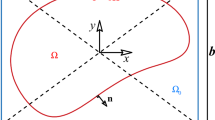Abstract
This paper discusses the application of the boundary contour method for resolving plate bending problems. The exploitation of the integrand divergence free property of the plate bending boundary integral equation based on the Kirchhoff hypothesis and a very useful application of Stokes' Theorem are presented to convert surface integrals on boundary elements to the computation of bending potential functions on the discretized boundary points, even for curved surface elements of arbitrary shape. Singularity and treatment of the discontinued corner point are not needed at all. The evaluation of the physics variant at internal points is also shown in this article. Numerical results are presented for some plate bending problems and compared against analytical and previous solutions.
Similar content being viewed by others
References
Altirero, N. J. and Sikarskie, D. L., 1978. A boundary integral method applied to plate of arbitrary plane form.Computer Structure,9: 283–305.
Chen, S. Y., Tang, W. X., Zhou, S. J., Leng, X. and Zheng, W., 1999. Evaluations of J integrals and stress intensity factors in a 2D quadratic boundary contour method.Commun. Numer. Meth. Engng. 15(2): 91–100.
Du, Q. H. and Lu, X. L., 1986. Boundary element method for aerospace plate.Chinese Acta of Aerospace,7: 6.
Du, Q. H., 1989. Boundary Integral Equation Method-boundary Element Method. High Education Publishing House, Bejing, p. 398.
Huang, K. Z., Xia, Z. X., Xue, M. D. and Ren, W. M., 1987. Theory for Plates and Shells. Qinghua University Press, Beijing.
Jaswon, M. A. and Maiti, M., 1968. An integral equation formulation of plate bending problems.J Engng Math.,2: 83–93.
Lutz, E. D., 1991. Numerical Methods for Hypersingular and Near Singular Boundary Integrals in Fracture Mechanics. Ph D. Dissertation, Cornell University, Ithaca, NY.
Lutz, E. D., Back, A., Gray, L. and Ingraffea, A., 1992. Systematic Conversion of Boundary Integral Surface Integrals to Contour Integral. Technical Report, April. Structure Engineering, School of Civil and Environmental Engineering, Cornell University, Ithaca, NY.
Maucher, R. and Hartmann, F., 1999. Corner singularities of Kirchhoff plates and the boundary element method.Comput. Methods Appl. Engng.,173: 273–285.
Mukherjee, S., 1982. Boundary Element Methods in Creep and Fracture. Elsevier Applied Science, London.
Mukherjee, Y. X., Mukherjee, S. and Shi, X., 1997. The boundary contour method for three-dimensional linear elasticity with a new quadratic boundary element.Engineering Analysis with Boundary Elements,20: 35–44.
Nagarajan, A., Lutz, E. D. and Mukherjee, S., 1994. A novel boundary element method for linear elasticity with no numerical integration for 2-D and line integrals for 3-D problems.ASME J. Appl. Mech.,61: 264–269.
Nagarajan, A., Mukherjee, S. and Lutz, E. D., 1996. The boundary contour method for three dimensional linear elasticity.ASME J. Appl. Mech.,63: 278–286.
Nardini, D. and Brebbia, C. A., 1982. A New Approach to Free Vibration Analysis using a Boundary Element Method.In: Brebbia C. A., editor. Boundary Element Method in Engineering.
Phan, A. V., Mukherjee, S. and Mayer, J. R. R., 1997. The boundary contour method for two-dimensional linear elasticity with quadratic boundary element.Computational Mechanics,20: 310–319.
Tanaka, M., Sladek, V. and Sladek, J., 1994. Regularization techniques applied to boundary element methods.Applied Mechanics Reviews,47(10): 457–499.
Timoshenko, S. and Wolnowsky-Krieger, S., 1959. Theory of Plate and Shells. McGraw-Hill, New York.
Toh, K. C. and Mukherjee, S., 1994. Hypersingular and finite part integrals in the boundary element method.International Journal of Solids and Structures,31(17): 2229–2312.
Tottenham, H., 1979. The Boundary Element Method for Plates and Shells.In: Banerjee PK, Butterfield R, editors. Development in Boundary Element Methods-I, London, Applied Science.
Wen, P. H., Aliabadi, M. H. and Rooke, D. P., 1998. A new method for transformation of domain integrals to boundary integrals in boundary element method.Commun Numer Mech Engng,14, 1055–1065.
Zhou, S. J., Sun, S. X. and Cao, Z. Y., 1998. The dual boundary contour method for two-dimensional crack problems.International Journal of Fracture,92: 201–212.
Zhou, S. J., Sun, S. X. and Cao, Z. Y., 1999a. The boundary contour method based on the equivalent boundary integral equation for 2-D linear elasticity.Commun. Numer. Meth. Engng,15: 811–821.
Zhou, S. J., Cao, Z. Y. and Sun, S. X., 1999b. The traction boundary contour method for linear elasticity.Int. J. Numer. Meth. Engng,46: 1883–1895.
Author information
Authors and Affiliations
Additional information
Project(No: ZE0208) supported by the National Science Foundation of Zhejiang Province, China
Rights and permissions
About this article
Cite this article
Song-ying, C., Le-qin, W. & Lei, J. Novel boundary element method for resolving plate bending problems. J. Zhejiang Univ. Sci. A 4, 584–590 (2003). https://doi.org/10.1631/jzus.2003.0584
Received:
Accepted:
Published:
Issue Date:
DOI: https://doi.org/10.1631/jzus.2003.0584



